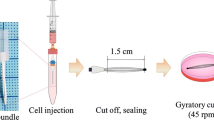Abstract
Selection of a cell line suitable for a hybrid artificial liver model employing cellulose porous beads (CPBs) was investigated. Hep G2 cells grown in a culture dish exhibited appreciably higher ureogenesis and gluconeogenesis activities than those grown in CPBs. SEM observation of CPBs revealed marked difference in the distribution of attached cells from one bead to another, and showed that almost all the cell-bearing micropores were completely packed with cells.
With the aim of selecting a cell line not prone to excessive aggregation and which grows moderately so as not to fill up the micropores, cells of 6 cell lines, HLE, HLF, Hep 3B, PLC/PRF/5, Huh 7 and Hep G2, were cultivated in dishes. Hep G2, HLE, and HLF increased to 5 × 105 cells/cm2, whereas PLC/PRF/5 grew only to 5 × 104, and Hep 3B and Huh 7 up to 2 × 104 cells/cm2. The specific activities of ureogenesis and gluconeogenesis of Huh 7 were the highest among the lines tested - 42- and 7-fold those of Hep G2, respectively. When the 6 cell lines were grown in a submerged culture with 0.6 g/l of CPBs, Huh 7 had the lowest cell concentration of 0.54 × 106 cells/ml, and the highest activities of ammonia consumption and urea and glucose production (1.38 μ mol NH3, 99 nmol urea, and 14.5 nmol glucose/106cells/h). Consequently, Huh 7 is considered to be a suitable cell line for use in the development of an artificial liver model employing porous beads.
Similar content being viewed by others
References
Aden DP, Fogel A, Plotkin S, Damjanov I and Knowles BB (1979) Controlled synthesis of HBsAg in a differentiated human liver carcinima-derived cell line. Nature 282: 615–616.
Doi I, Namba M, Sato J (1975) Establishment and some biological characteristics of human hepatoma cell lines. Gann 66: 385–392.
Ijima H, Matsushita T and Funatsu K (1993) Development of a hybrid type artificial liver using PUF/spheroid culture system of adult hepetocytes. Jpn. J. Artif. Organs 22: 171–176.
Kasai S, Sawa M, Tomita I, Hashimoto M, Jiang B, Hirai S, Kakisaka A, Yamamoto T, Mito M and Inoue M (1993) Metabolic activities of multiporous cellulose microcarrier attached hepatocytes. Jpn. J. Artif. Organs 22: 159–163.
Macnab GM, Alexander JJ, Lecatsas G, Bey EM and Urbanowicz JM (1976) Hepatitis B surface antigen produced by a human hepatoma cell line. Br. J. Cancer 34: 509–515.
Miyoshi H, Yanagi H, Furukawa K and Ohshima N (1993) Continuous culture of hepatocytes under different medium conditions using a packed-bed reactor loaded with porous resins. Jpn. J. Artif. Organs 22: 147–152.
Nakabayashi H, Taketa K, Miyano K, Yamane T and Sato J (1982) Growth of human hepatoma cell lines with differentiated functions in chemically defined medium. Cancer Res. 42: 3858–3863.
Nyberg SL, Shatford RA, Peshwa MV, White HG, Cerra FB ans Hu W-S (1993) Evaluation of a hepatocyte.entrapment hollow fiber reactor: A potential bioartificial liver. Biotech. Bioeng. 41: 194–203.
Park S and Stephanopoulos G (1993) Packed bed bioreactor with porous ceramic beads for animal cell culture. Biotech. Bioeng. 41: 25–34. 34.
Razga J, Holzman MD, Ro M-S, Griffin DW, Neuzil DF, Giorgio T, Moscioni AD and Demetriou AA (1993) Development of a hyvrid bioartificial liver. Annals. Surgery 217: 502–511.
Sakai Y and Suzuki M (1994) Functional expressions by hepatocyte spheroids entrapped in collagen gel in hallow fiber modules Jpn. J. Artif. Organs 23: 473–478.
Sanford KK, Earle WR, Evans VJ, Waltz HK and Shannon JE (1959) The measurement of proliferation in tissue cultures by enumeration of cell nuclei. J. Nat. Canc. Inst. 11: 773–795.
Sussman NL and Kelly JH (1993) Improved liver function following treatment with an extracorporeal liver assist device. Artif. Organs 17: 27–30.
Takagi M, Shirokaze J, Oishi K, Otsubo K, Yamamoto K, Yoshida N and Fujimatsu I (1994) Production of S-(+)-ibuprofen with high optical purity from a nitrile compounds by cells immobilized on cellulose porous beads. J. Ferment. Bioeng. 78: 191–193.
Takeshita K, Ishibashi H, Suzuki M, Tobe S, Takei Y, Kishida A, Akaike T and Kodama M (1993) High cell-density culture system of hepatocytes entrapped in a three dimensional collagen-gel matrix using a hollow fiber module. Jpn. J. Artif. Organs 22: 153–158.
Author information
Authors and Affiliations
Rights and permissions
About this article
Cite this article
Takagi, M., Fukuda, N. & Yoshida, T. Comparison of different hepatocyte cell lines for use in a hybrid artificial liver model. Cytotechnology 24, 39–45 (1997). https://doi.org/10.1023/A:1007927906986
Issue Date:
DOI: https://doi.org/10.1023/A:1007927906986




